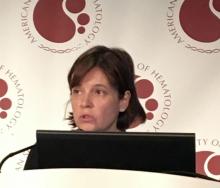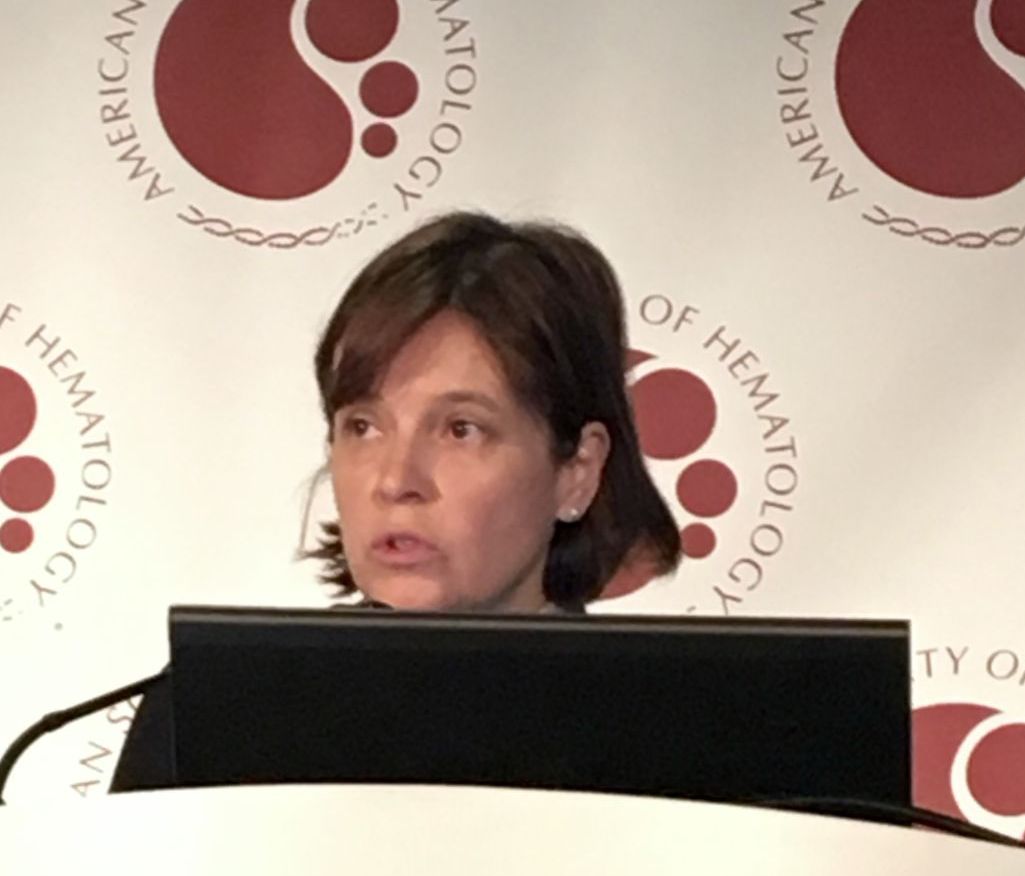User login
ATLANTA – Intrabone gene therapy could offer long-term hope for patients with beta thalassemia who cannot be treated by allogeneic hematopoietic stem cell transplant (HSCT), suggest the results of a phase 1/2 trial.
After a median of 16 months of follow-up, five of seven patients who received this novel gene therapy needed markedly fewer blood transfusions than at baseline, lead investigator Sarah Marktel, MD, reported at the annual meeting of the American Society of Hematology.
Even more strikingly, (indicating severe disease), said Dr. Marktel of San Raffaele Scientific Institute and San Raffaele Telethon Institute for Gene Therapy (SR-Tiget), Milan.
All patients met the trial’s primary safety endpoint and experienced no treatment-related adverse effects except those caused by conditioning chemotherapy, such as infections, Dr. Marktel said. She and her coinvestigators are expanding the study by administering intrabone gene therapy to three more children.
Beta-thalassemia is a genetic anemia linked to multiple mutations of the beta-globin gene. Patients who can’t undergo allogeneic HSCT face a lifetime of blood transfusions and iron chelation. This is the reality for most because they lack a compatible donor, have exclusionary risk factors for allogeneic transplant, or cannot access treatment, Dr. Marktel said during a press briefing.
Although this is not the first human study of gene therapy in beta-thalassemia, it is the first to infuse treatment directly into bone marrow instead of peripheral blood.
“Compared to previous trials, patients showed evidence of successful engraftment [proliferation in bone marrow] sooner after receiving the therapy,” Dr. Marktel said. Researchers saw evidence of engraftment as soon as 10 days after treatment – noticeably faster than in prior gene therapy studies of beta-thalassemia, she added.
To develop this treatment, investigators created a self-inactivating lentiviral vector (dubbed GLOBE) that carries a normal beta-globin gene. The vector posted encouraging safety and efficacy signals in studies of human thalassemic cells and in a mouse model, Dr. Marktel said.
For the phase 1/2 trial, the researchers extracted circulating CD34+ stem cells from the peripheral blood from three adults and four children with transfusion-dependent beta-thalassemia. For each patient, they transduced these stem cells with GLOBE. Next, patients underwent a 3-day conditioning regimen of treosulfan and thiotepa, after which their individual cell-gene product was infused into their own bone marrow.
This is a small study, but if results hold up in more patients, gene therapy “could represent an alternative to bone marrow transplantation that does not require a matched donor or immunosuppression and that carries no risk of graft-versus-host disease or transplant rejection,” Dr. Marktel said. Children in this study might have had better results because their younger stem cells are more amenable to gene transduction and engraftment, she hypothesized.
Both beta-0/beta-0 patients in the study are children. One continues to need blood transfusions because he experiences a drop in genetically modified cells and vector copy numbers soon after each infusion of gene therapy. The other was treated more than a year ago and remains transfusion free.
“The beta-0/beta-0 genotype is toughest to treat with gene therapy,” Dr. Marktel noted. “In comparison, beta-0/beta+ or beta+/beta+ patients have the highest chances of becoming transfusion independent because they can contribute their own hemoglobin to the total hemoglobin output.”
Telethon Foundation provided funding. Dr. Marktel disclosed research funding from GlaxoSmithKline, which has licensed the therapy.
SOURCE: Marktel S et al. ASH 2017 Abstract 355.
ATLANTA – Intrabone gene therapy could offer long-term hope for patients with beta thalassemia who cannot be treated by allogeneic hematopoietic stem cell transplant (HSCT), suggest the results of a phase 1/2 trial.
After a median of 16 months of follow-up, five of seven patients who received this novel gene therapy needed markedly fewer blood transfusions than at baseline, lead investigator Sarah Marktel, MD, reported at the annual meeting of the American Society of Hematology.
Even more strikingly, (indicating severe disease), said Dr. Marktel of San Raffaele Scientific Institute and San Raffaele Telethon Institute for Gene Therapy (SR-Tiget), Milan.
All patients met the trial’s primary safety endpoint and experienced no treatment-related adverse effects except those caused by conditioning chemotherapy, such as infections, Dr. Marktel said. She and her coinvestigators are expanding the study by administering intrabone gene therapy to three more children.
Beta-thalassemia is a genetic anemia linked to multiple mutations of the beta-globin gene. Patients who can’t undergo allogeneic HSCT face a lifetime of blood transfusions and iron chelation. This is the reality for most because they lack a compatible donor, have exclusionary risk factors for allogeneic transplant, or cannot access treatment, Dr. Marktel said during a press briefing.
Although this is not the first human study of gene therapy in beta-thalassemia, it is the first to infuse treatment directly into bone marrow instead of peripheral blood.
“Compared to previous trials, patients showed evidence of successful engraftment [proliferation in bone marrow] sooner after receiving the therapy,” Dr. Marktel said. Researchers saw evidence of engraftment as soon as 10 days after treatment – noticeably faster than in prior gene therapy studies of beta-thalassemia, she added.
To develop this treatment, investigators created a self-inactivating lentiviral vector (dubbed GLOBE) that carries a normal beta-globin gene. The vector posted encouraging safety and efficacy signals in studies of human thalassemic cells and in a mouse model, Dr. Marktel said.
For the phase 1/2 trial, the researchers extracted circulating CD34+ stem cells from the peripheral blood from three adults and four children with transfusion-dependent beta-thalassemia. For each patient, they transduced these stem cells with GLOBE. Next, patients underwent a 3-day conditioning regimen of treosulfan and thiotepa, after which their individual cell-gene product was infused into their own bone marrow.
This is a small study, but if results hold up in more patients, gene therapy “could represent an alternative to bone marrow transplantation that does not require a matched donor or immunosuppression and that carries no risk of graft-versus-host disease or transplant rejection,” Dr. Marktel said. Children in this study might have had better results because their younger stem cells are more amenable to gene transduction and engraftment, she hypothesized.
Both beta-0/beta-0 patients in the study are children. One continues to need blood transfusions because he experiences a drop in genetically modified cells and vector copy numbers soon after each infusion of gene therapy. The other was treated more than a year ago and remains transfusion free.
“The beta-0/beta-0 genotype is toughest to treat with gene therapy,” Dr. Marktel noted. “In comparison, beta-0/beta+ or beta+/beta+ patients have the highest chances of becoming transfusion independent because they can contribute their own hemoglobin to the total hemoglobin output.”
Telethon Foundation provided funding. Dr. Marktel disclosed research funding from GlaxoSmithKline, which has licensed the therapy.
SOURCE: Marktel S et al. ASH 2017 Abstract 355.
ATLANTA – Intrabone gene therapy could offer long-term hope for patients with beta thalassemia who cannot be treated by allogeneic hematopoietic stem cell transplant (HSCT), suggest the results of a phase 1/2 trial.
After a median of 16 months of follow-up, five of seven patients who received this novel gene therapy needed markedly fewer blood transfusions than at baseline, lead investigator Sarah Marktel, MD, reported at the annual meeting of the American Society of Hematology.
Even more strikingly, (indicating severe disease), said Dr. Marktel of San Raffaele Scientific Institute and San Raffaele Telethon Institute for Gene Therapy (SR-Tiget), Milan.
All patients met the trial’s primary safety endpoint and experienced no treatment-related adverse effects except those caused by conditioning chemotherapy, such as infections, Dr. Marktel said. She and her coinvestigators are expanding the study by administering intrabone gene therapy to three more children.
Beta-thalassemia is a genetic anemia linked to multiple mutations of the beta-globin gene. Patients who can’t undergo allogeneic HSCT face a lifetime of blood transfusions and iron chelation. This is the reality for most because they lack a compatible donor, have exclusionary risk factors for allogeneic transplant, or cannot access treatment, Dr. Marktel said during a press briefing.
Although this is not the first human study of gene therapy in beta-thalassemia, it is the first to infuse treatment directly into bone marrow instead of peripheral blood.
“Compared to previous trials, patients showed evidence of successful engraftment [proliferation in bone marrow] sooner after receiving the therapy,” Dr. Marktel said. Researchers saw evidence of engraftment as soon as 10 days after treatment – noticeably faster than in prior gene therapy studies of beta-thalassemia, she added.
To develop this treatment, investigators created a self-inactivating lentiviral vector (dubbed GLOBE) that carries a normal beta-globin gene. The vector posted encouraging safety and efficacy signals in studies of human thalassemic cells and in a mouse model, Dr. Marktel said.
For the phase 1/2 trial, the researchers extracted circulating CD34+ stem cells from the peripheral blood from three adults and four children with transfusion-dependent beta-thalassemia. For each patient, they transduced these stem cells with GLOBE. Next, patients underwent a 3-day conditioning regimen of treosulfan and thiotepa, after which their individual cell-gene product was infused into their own bone marrow.
This is a small study, but if results hold up in more patients, gene therapy “could represent an alternative to bone marrow transplantation that does not require a matched donor or immunosuppression and that carries no risk of graft-versus-host disease or transplant rejection,” Dr. Marktel said. Children in this study might have had better results because their younger stem cells are more amenable to gene transduction and engraftment, she hypothesized.
Both beta-0/beta-0 patients in the study are children. One continues to need blood transfusions because he experiences a drop in genetically modified cells and vector copy numbers soon after each infusion of gene therapy. The other was treated more than a year ago and remains transfusion free.
“The beta-0/beta-0 genotype is toughest to treat with gene therapy,” Dr. Marktel noted. “In comparison, beta-0/beta+ or beta+/beta+ patients have the highest chances of becoming transfusion independent because they can contribute their own hemoglobin to the total hemoglobin output.”
Telethon Foundation provided funding. Dr. Marktel disclosed research funding from GlaxoSmithKline, which has licensed the therapy.
SOURCE: Marktel S et al. ASH 2017 Abstract 355.
REPORTING FROM ASH 2017
Key clinical point: Gene therapy engraftment was achieved sooner using intrabone delivery.
Major finding: After a median of 16 months of follow-up, five of seven patients who received this novel gene therapy needed markedly fewer blood transfusions than at baseline.
Data source: An interventional phase 1/2 trial of seven patients with transfusion-dependent beta thalassemia.
Disclosures: Telethon Foundation provided funding. Dr. Marktel disclosed research funding from GlaxoSmithKline, which has licensed the therapy.
Source: Marktel S et al. ASH 2017 Abstract 355.

